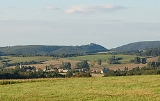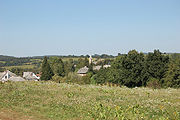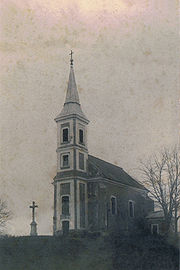
Porva
Encyclopedia
Location

Veszprém (county)
Veszprém is the name of an administrative county in Hungary. Veszprém is also the name of the capital city of Veszprém county.-Veszprém county:...
, Hungary
Hungary
Hungary , officially the Republic of Hungary , is a landlocked country in Central Europe. It is situated in the Carpathian Basin and is bordered by Slovakia to the north, Ukraine and Romania to the east, Serbia and Croatia to the south, Slovenia to the southwest and Austria to the west. The...
. Located in the High Bakony Mountains, 6 km
(3.75 mi) from the city of Zirc and it is
around 400 m (1313 ft) above sea level. From the village and
the surrounding country side the twin caps of the Koris-hill
(709 m or 2326 ft) and the Kék-hill (661 m or 2168 ft)
creates a beautiful panoramic view.
By car 5 minutes from Zirc
Zirc
-Attractions:*Zirc Abbey, a Cistercian abbey*Zirc Arboretum*Bakony Museum of Natural Sciences, situated in the territory of Zirc Abbey-External links:*...
with its historical abbey
Zirc Abbey
Zirc Abbey, formerly also Zircz Abbey, also known as Zircensis or Boccon, is a Cistercian abbey, situated in Zirc in the Diocese of Veszprém, Hungary.-First period:...
, about 30 minutes from the beautiful city of Veszprém
Veszprém
Veszprém is one of the oldest urban areas in Hungary, and a city with county rights. It lies approximately north of the Lake Balaton. It is the administrative center of the county of the same name.-Location:...
, 40 minutes from lake Lake Balaton
Lake Balaton
Lake Balaton is a freshwater lake in the Transdanubian region of Hungary. It is the largest lake in Central Europe, and one of its foremost tourist destinations. As Hungary is landlocked , Lake Balaton is often affectionately called the "Hungarian Sea"...
, 45 minutes from Gyor
Gyor
-Climate:-Main sights:The ancient core of the city is Káptalan Hill at the confluence of three rivers: the Danube, Rába and Rábca. Püspökvár, the residence of Győr’s bishops can be easily recognised by its incomplete tower. Győr’s oldest buildings are the 13th-century dwelling tower and the...
, the city of three streams, 1,5 hours from Budapest
Budapest
Budapest is the capital of Hungary. As the largest city of Hungary, it is the country's principal political, cultural, commercial, industrial, and transportation centre. In 2011, Budapest had 1,733,685 inhabitants, down from its 1989 peak of 2,113,645 due to suburbanization. The Budapest Commuter...
and Bratislava
Bratislava
Bratislava is the capital of Slovakia and, with a population of about 431,000, also the country's largest city. Bratislava is in southwestern Slovakia on both banks of the Danube River. Bordering Austria and Hungary, it is the only national capital that borders two independent countries.Bratislava...
and 2 hours from Vienna
Vienna
Vienna is the capital and largest city of the Republic of Austria and one of the nine states of Austria. Vienna is Austria's primary city, with a population of about 1.723 million , and is by far the largest city in Austria, as well as its cultural, economic, and political centre...
.
History

Pannonhalma Archabbey
The Benedictine Pannonhalma Archabbey is the most notable landmark in Pannonhalma and one of the oldest historical monuments in Hungary, founded in the year 996. It is located near the town, on top of a hill...
.
Between 1782 and 1784 the current church was erected over the ruins of the palos monastery. The building was built in a gothic baroque style. There is very little left from its rich history. The ruins were buried and the cultural treasures were stolen or moved to other places. The old palos monastery was already deserted during the beginning of the Turkish occupation.
On the ruins stand the numerous time renovated church guarding the past centuries spirit. The descendant of the Szapolyai family Perenszy Pálné born Zápolya Orsolya was buried in 1520 in a red marble mausoleum that is still visible today. The churches main altar was built by Roskovitz Ignác the floor is covered with kelheim stones. The building is in gothic style with baroque sections outside and inside. On the face of the church two marble memorials were erected for the memory of the first and Second World War’s casualties from the village.
On the north wall of the church the original monasteries base walls are still there. The rich history of the town and place names are evident.
The church and the vicarage of Porva used to belong to the Archabbey of Pannonhalma. After World War II however the Russian invaders took possession of the vicarage to establish their regional headquarters. The Facade of the vicarage was destroyed as a Russian repercusion for the Hungarian revolution of 1956
Surroundings
Porva is considered to be in one of the most beautiful spots in the High Bakony Mountains, in North-Western Hungary.Köris-hill (Hungarian:Köris-hegy), the Bakony hills highest point, forms together with the neighbouring Kék-hill (Hungarian:(Kék-hegy) the most beautiful part of the area. Itis used as a compass by the travelers of the Bakony hills especially because of the lookout tower on the top of Köris-hegy named after Vajda Péter (1808–1846) a famous naturalist and poet-writer. On a clear day if you climb the mountain you can enjoy the view. First of Porva and its neighbor Borzavár, further away the Vértes hills the shimmering Balaton, the Badacsony hills to the north Pannonhalma on the broad horizon. And with a particular clear sky even the white tops of the Alps in Austria.
From Porva it is a 2 kilometers walk through the surrounding forests to The High Bakony Park on the slopes of the Kék-hill and the Köris-hill and about 5 kilometers to the top of Köris-hegy.
The region is a paradise for outdoor activities like hiking, horse riding, swimming and ballooning.
The Csárda-teto (441 m or 1312 ft) according to local legends is a noteworthy place. This was a meeting place for
the local bandits (betyár) Rózsa Sándor, Zsubri, Panduri and Savanyu Jóska. Even today there are traces and stone
ruins of the inn (csárda). Because of the prevalent highwayman activities many of the local caves are named
after its old occupants. These caves are found along the valley of the Cuha-patak (Cuha-stream): Savanyú Jóska cave,
(Kopince-barlang) Betyár-pamlag, Remete-barlang, Zsivány-barlang. The closest famous springs are Bön-kút,
Zsellér-ko kút, Csörgo-kút, Néma-kút etc. Of all the numerous springs the most notable water of Porva is the
Hódos-ér (Hódos-creek) flowing into the Cuha about 10 km (6.25 mi) from the village.
The valley of the Cuha-patak is a very popular tourist destination with many interesting sights. The valley is
famous for the blooming wild-cyclamen flowers. The
surrounding forests are full of many different flowers and
vegetation. If you hike silently especially in the winter –
deer, wild boar, stag deer, fox and sometime a herd of wild
sheep (muflon) may cross your path.
From early spring to October the tourist
traffic is heavy at the porva-csesznek rail station. Most
favor this section of the valley.
Places to stay
Porva InnHovirag Panzio
Hotel Szepalma
External links
47.311304°N 17.814589°W

